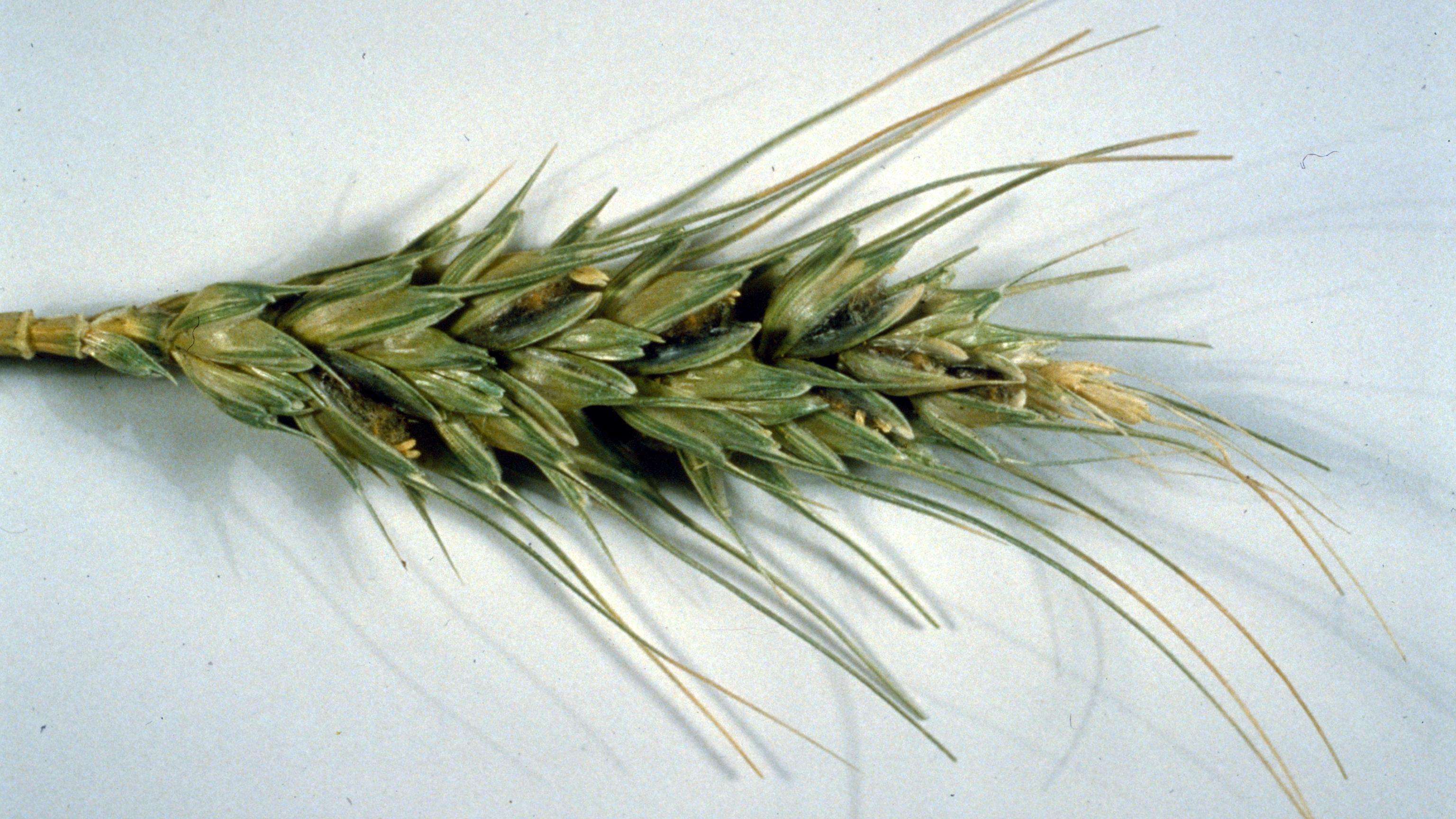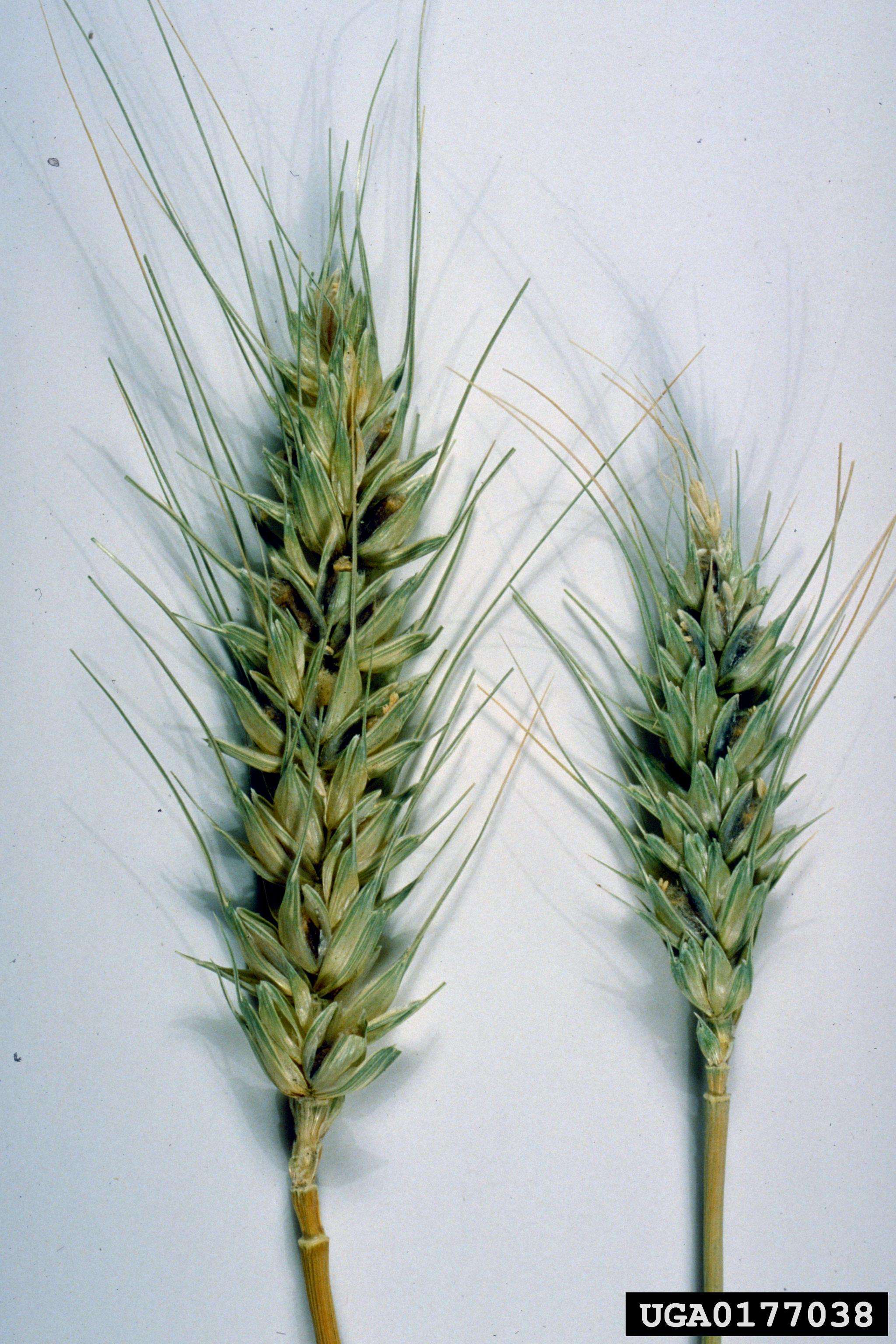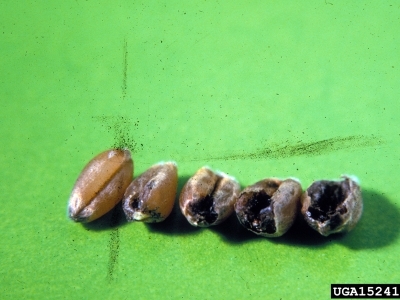Karnal Bunt

Ruben Durán, Washington State University, Bugwood.org
Karnal bunt, also called partial bunt, is a plant disease affecting wheat, durum wheat, and triticale (a hybrid of wheat and rye). The Karnal bunt fungus (Tilletia indica Mitra) and the plant disease it causes are harmless to people and animals and has little impact on crop yield or quality. Karnal bunt was first detected in 1996 in the United States in Arizona and then later in Texas and California.
APHIS regulates this disease because many trading partners require that U.S. wheat be certified as grown in areas free of Karnal bunt. Karnal bunt is quarantined to portions of two counties in Arizona, and the disease incidence in these regulated fields is minimal (usually less than 0.1 percent in the United States). APHIS also oversees an annual voluntary survey of grain delivered to elevators to check for Karnal bunt across the country.
Karnal bunt is usually identified after harvest, once the grains are separated and infected kernels are exposed. Here's what you'll see and smell:
- Appearance
- Bunted kernels are fragile, blackened, and sooty. The kernels' outer layer will have cracks, and if you press them, you'll see a black powder. In advanced infections, wheat kernels look like a boat or dugout canoe.
- Fishy Odor
If the disease is severe, kernels will produce trimethylamine, which gives off a strong, fishy smell.


Two heads of common wheat with symptoms of Karnal bunt. Ruben Durán, Washington State University, Bugwood.org
Wheat kernels and bunted wheat kernels caused by Tilletia indica. Department of Plant Pathology, North Carolina State University, Bugwood.org
You can reduce the risk of spreading Karnal bunt by using clean seed, ongoing sanitation, sound agricultural practices, and following quarantine regulations for both imported regulated articles and impacted domestic areas.
You can manage the disease by cooperating with State and Federal officials and following regulations. It is equally important to use clean seed, proper sanitation, and sound agricultural practices.
Report Plant Pests and Diseases
Have you seen this pest or signs of pest damage? Immediately report your findings.
Find your State plant regulatory official
Find your State plant health director
Controlling Karnal Blunt
A successful quarantine and national survey program have confined Karnal bunt to portions of one State: Arizona. Because the fungus-causing disease poses no harm to people or animal health, there are no Federal food regulations concerning Karnal bunt. Every year since 1996, APHIS has coordinated a Karnal bunt national survey in wheat-producing counties, outside of regulated areas in Arizona. To date, Karnal bunt hasn't been found in these surveys.
- November 2025 Regulated Area Map (823.99 KB)
- October 2024 Regulated Area Map (823.94 KB)
- February 2024 Regulated Area Map (823.91 KB)
- April 2023 Regulated Area Map (824.83 KB)
- January 2023 Regulated Area Map (1.04 MB)
- Regulated Areas (139.63 KB)
- Regulated Articles (168.52 KB)
Code of Federal Regulations
- Domestic Regulations - 7 CFR 301.89-1 through 301.89-16
- Federal Register Notices
Federal Orders
- March 20, 2025, APHIS Reduces Karnal Bunt (Tilletia indica) Regulated Areas in Maricopa County in Arizona (191.08 KB)
- October 11, 2024, APHIS Reduces Karnal Bunt (Tilletia indica) Regulated Areas in Pinal County in Arizona (177.91 KB)
- February 14, 2024, APHIS Reduces Karnal Bunt (Tilletia indica) Regulated Areas in Maricopa and Pinal Counties in Arizona (159.17 KB)
- April 24, 2023, APHIS Amends Karnal Bunt (Tilletia indica) Regulated Areas in Maricopa County in Arizona (153.86 KB)
- December 29, 2022, APHIS Amends Karnal Bunt (Tilletia indica) Regulated Areas in La Paz, Maricopa, and Pinal Counties in Arizona (185.01 KB)
- August 17, 2022, APHIS Amends Karnal Bunt (Tilletia indica) Regulated Areas in La Paz, Maricopa, and Pinal Counties in Arizona (216.32 KB)
Import Regulatory Information
APHIS may recognize an area as free of Karnal bunt whenever we determine that the area meets the requirements of the International Standard for Phytosanitary Measures (ISPM) No. 4. To provide the public with current, valid information, we will publish a notice in the Federal Register and maintain on our Karnal bunt web pages a list of the specific areas where Karnal bunt is not known to occur. Areas listed as being free from Karnal bunt are subject to audit by APHIS to verify that they continue to merit such listing.
- Import Regulations - 7 CFR 319.59
Karnal bunt is known to occur in the following areas outside the United States:
| Country | Areas Within a Country |
|---|---|
| Afghanistan | |
| India | |
| Iran | |
| Iraq | |
| Mexico | Chihuahua, Guanajuato, Jalisco, Michoacan, Queretaro, and Mexicali Valley in Sonora and Baja California |
| Nepal | |
| Pakistan | |
| South Africa |
Karnal Bunt Pest-Free Areas
The APHIS Administrator may recognize an area as free of Karnal bunt whenever they determine that the area meets the requirements of the International Standard for Phytosanitary Measures (ISPM) No. 4, “Requirements for the establishment of pest free areas.” The international standard was established by the International Plant Protection Convention of the United Nations' Food and Agriculture Organization and is incorporated by reference in 7 CFR § 300.5. To provide the public with current, valid information, APHIS will publish a notice in the Federal Register and maintain on our website a list of the specific areas that are approved as areas in which Karnal bunt is not known to occur. Areas listed as being free from Karnal bunt are subject to audit by APHIS to verify that they continue to merit such listing.
The following area of the Mexicali Valley in Mexico has been determined to be free from Karnal bunt:
- Those portions of the municipality of Mexicali, in the State of Baja California, and the municipality of San Luis Rio Colorado, in the State of Sonora, that are included in the Distrito de Desarrollo Rural (Rural Development District) 002 Rio Colorado
Except for wheat (Triticum spp.) plants, which are prohibited importation under § 319.37, § 319.59, or both, approved articles that are from recognized pest-free areas may be imported into the United States subject to all of the following conditions:
- The articles are offered for entry at the port of Calexico, CA.
- The articles offered for entry are made available for examination by an inspector and remain at the port until released, or authorized further movement pending release, by an inspector.
- The articles are accompanied by a phytosanitary certificate issued by the Mexican national plant protection organization that certifies the articles are from the area of the Mexicali Valley described above and remained within that area before and during their movement to the United States.
- USDA Economic Research Service (ERS) Outlook Report: Economic Implications of Ending the Issuance of Karnal Bunt Phytosanitary Wheat Export Certificates (1.63 MB) - This report provides the results of ERS research on the economic consequences of ending the USDA Karnal bunt certification program for U.S. exports to countries that ban import of wheat from countries known to have the disease.



